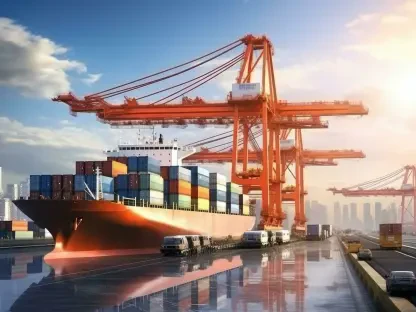Digital Freight Transformation: Setting the Stage for a Market Overhaul
The road transport sector in Europe stands at a critical juncture, where administrative costs could be cut by as much as 70% and paperwork processing time reduced by 60% through the adoption of electronic Consignment Notes (eCMR). This seismic shift, driven by the EU’s push for digitalization, is not just a regulatory mandate but a transformative opportunity for hauliers to redefine their operational margins. As the industry navigates this transition, understanding the market dynamics and potential gains becomes essential for staying competitive in a landscape with razor-thin profits.
This analysis delves into the current trends propelling eCMR adoption, backed by hard data from pilot programs across Europe. It examines how these digital tools are reshaping cost structures, streamlining workflows, and contributing to sustainability goals. With a critical deadline on the horizon, the focus is on how early adopters are positioning themselves for success and what this means for the broader market over the next few years.
Market Trends and Data Insights: The Rise of eCMR
Cost Efficiency Metrics: A Game-Changing Reduction
Pilot programs across Europe provide compelling evidence of eCMR’s impact on cost structures. In Italy, a collaborative project reported savings ranging from 54% to 83% for transport companies adopting digital consignment notes, depending on fleet size and operational setups. These savings, translating to an estimated €2,000 annually per company and over €1 million nationwide, stem from reduced administrative labor and minimized errors that often inflate expenses in paper-based systems. While the potential for a 70% cost reduction is clear, smaller operators face challenges with initial investments in digital infrastructure, highlighting a disparity in market readiness.
Time Savings: Accelerating Operational Workflows
Time efficiency emerges as another cornerstone of eCMR’s value proposition. Italian trials demonstrated a drop in administrative processing per consignment from 50 minutes to just 20, marking a 60% reduction. A parallel study in Denmark revealed freight order processing shrinking from 23 minutes to 9 minutes with digital tools. Scaled across Europe, these efficiencies could save between 75 and 102 million work hours annually, equivalent to freeing up 50,000 full-time administrative positions for more strategic roles. However, achieving uniform gains depends on interoperable systems and widespread adoption, areas where regional variations still pose risks.
Sustainability Impact: Aligning with Green Market Demands
Beyond financial metrics, eCMR aligns with growing environmental priorities in the transport sector. Estimates suggest that digital freight documentation could save €1 billion yearly in administrative costs while eliminating 160 million paper sheets across the EU. For companies under pressure to meet sustainability reporting standards, this reduction in paper usage and storage needs offers tangible benefits to carbon footprint metrics. Despite these advantages, some market players harbor concerns about the reliability of digital systems during inspections, underscoring the need for robust training and standardized protocols to ensure seamless integration.
Future Projections: Navigating Toward a Digital Deadline
Regulatory Milestones and Market Adoption Timeline
With the EU’s Electronic Freight Transport Information Regulation mandating acceptance of digital freight documentation by July 2027, the market is gearing up for a significant shift over the next two years. Technical rules for platform certification and data access are already in place as of this year, setting the stage for accelerated adoption in 2026. Industry forecasts indicate that large-scale implementation will peak next year as national guidelines solidify and training programs expand, pushing hauliers to integrate certified systems to meet compliance and gain operational edges.
Competitive Landscape: Early Movers vs. Laggards
The competitive dynamics of eCMR adoption are becoming increasingly evident. Early adopters are expected to leverage faster invoicing and reduced overheads to undercut slower competitors, potentially redefining pricing structures in a market with traditionally low margins. Regions like France, Spain, and the Netherlands are ahead in domestic implementation, while others lag, creating an uneven playing field. Market analysis suggests that bridging this gap will require targeted support for smaller operators and harmonized inspection practices to ensure digital tools deliver consistent value across borders.
Technological Evolution: Enhancing Market Capabilities
Looking ahead, advancements in certified platforms are poised to further elevate eCMR’s role in the market. Enhanced shipment visibility, seamless integration with transport management systems, and real-time data access are likely to become standard features, driving operational transparency. Economic pressures will also compel more hauliers to adopt digital solutions, as staying competitive hinges on efficiency gains. The market outlook points to a widening gap between those who invest in technology now and those who delay, with long-term implications for profitability and customer relations.
Strategic Reflections: Capitalizing on the eCMR Wave
Reflecting on the market analysis, it becomes evident that eCMR adoption has already started to transform the road transport sector with proven reductions of 70% in costs and 60% in processing times during initial pilots. The environmental benefits and improved cash flows further solidify its strategic importance for hauliers navigating tight margins. These early insights underscore a pivotal moment where digital tools move beyond compliance to become core competitive levers.
For transport operators, the path forward involves actionable steps like integrating eCMR into systems by next year, ensuring software compliance with certified standards, and prioritizing staff training for digital workflows. Updating contracts to validate digital proof of delivery also emerges as a critical measure to prevent payment delays. By taking these steps, companies can position themselves not just to meet regulatory demands but to harness efficiency gains that reshape their market standing, setting a precedent for broader industry evolution.









